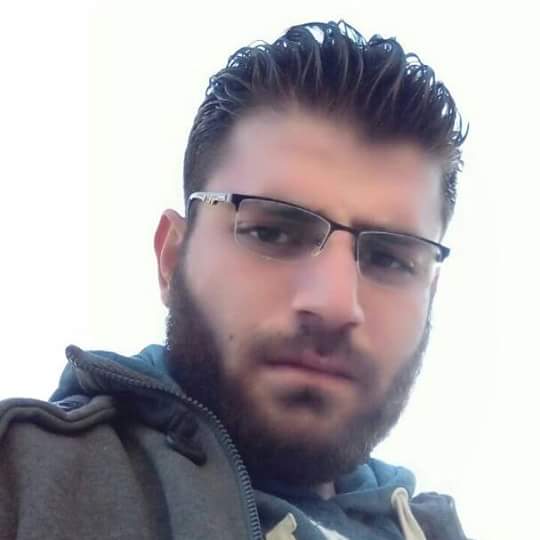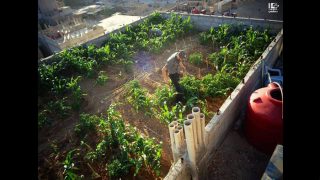Before Syria plunged into war, the town of Murak prided itself on its world-famous pistachios. Now it’s red gold hardly glimmers, even in the domestic market.
The last years have been tough on the pistachio farmers and traders of Murak, a small town in the northern countryside of Hama. As armed mobilization began to take hold of Murak in 2012, the regime started to bombard the town and spared no effort in destroying it economically. The regime deliberately targeted vital facilities as well as the sources and means of livelihood of its people, namely pistachio production, which was the largest in Syria at the time and a source of income for the majority of Murak residents.
This investigation examines the impact of the Syrian war on the pistachio market, which is emerging anew as locals and farmers overcome multiple hurdles in a bid to restore production.
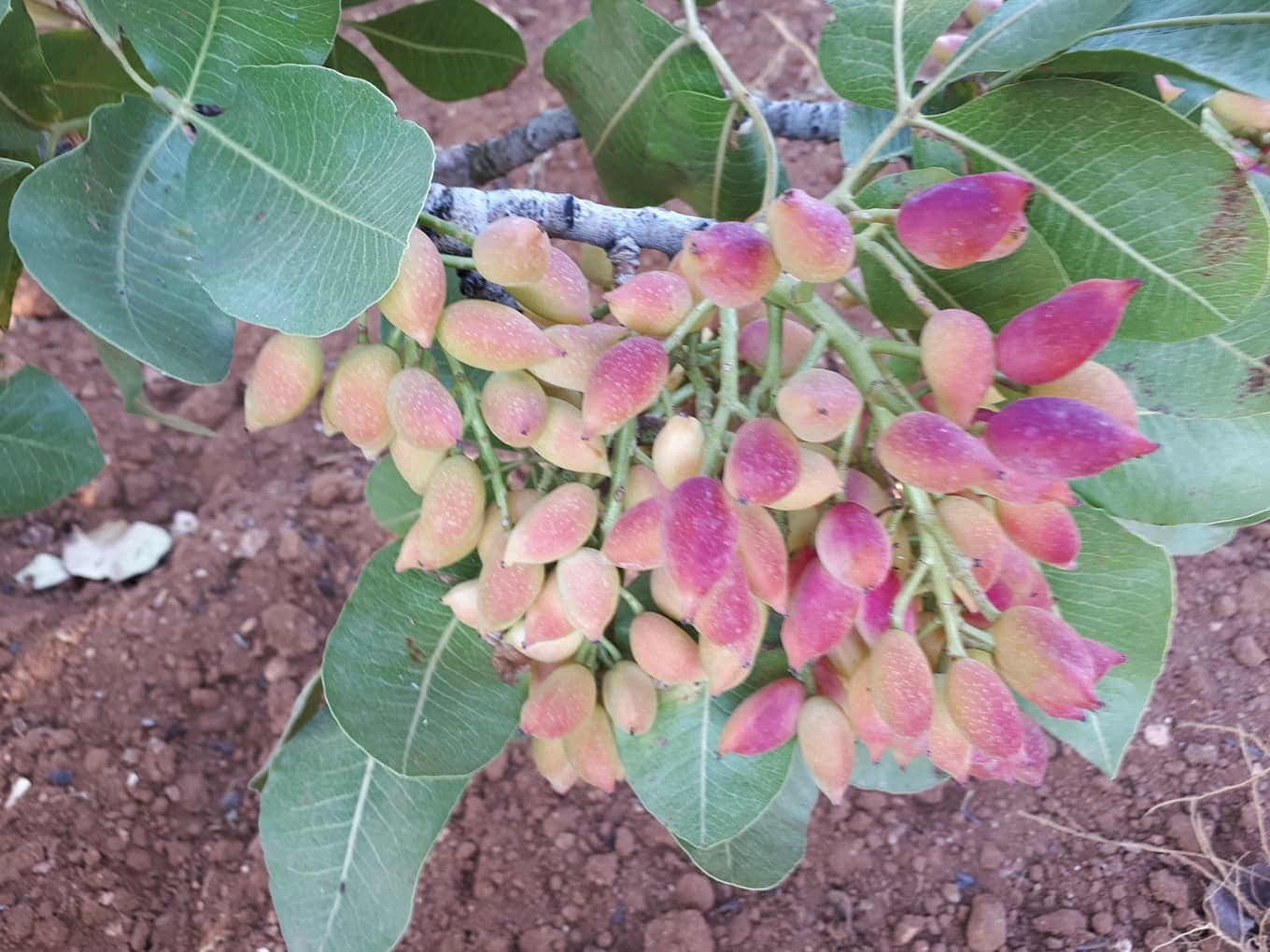
Along with Turkey's southeastern region of Anatolia, Syria is considered an ancestral home of the pistachio tree. Its discovery dates back to the time of the Assyrians, circa 3,500 B.C. In 2010, Syria ranked fourth globally in pistachio production, naming the pistachio its Golden Tree. In the northern Hama countryside, Murak is Syria’s primary pistachio reservoir, and is known as the City of Red Gold.
Murak: The City of Red Gold, and Syria’s Pistachio Basket
Up until the Syrian revolution in 2011, it had been the first area to be cultivated with a single agricultural crop (pistachios). The land used for pistachio cultivation was around 4,000 hectares, with the tree count nearing 800,000, of which 750,000 were fruitful. Murak contributed nearly 60% of total pistachio production in Syria, accounting for more than 40,000 tons of the 63,000 tons of national annual production.
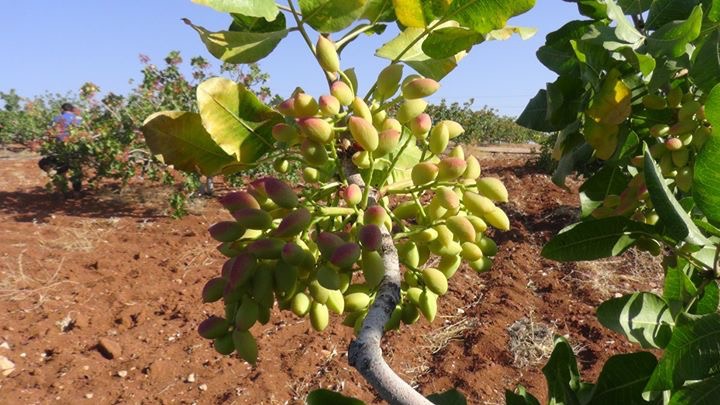
After more than a year of bombardment and tough battles with the Syrian army, Murak came under the control of the opposition Free Syrian Army faction Jaysh Al-Izza in November 2015. The fighting took a toll on farmers like Mahmoud Meri (64).
“I have broken my back working this land,” lamented Meri in an interview with Syria Untold. “Year-round, it requires constant irrigation, fertilizers, funds and toiling. Yet at harvest, whoever has a yield from their land is at a loss, unable to find a market for it.”
“The farmers of the town and the surrounding villages, along with some villagers from Idlib, would transfer the pistachios to designated town markets,” Meri continued. “But the shelling that has destroyed the town didn’t spare a market or anything else. The excess supply in pistachios caused a collapse in its value. This has forced the famers to store them for a limited time. If the local market is not stimulated, they may remain in storage until the next season.”
Despite the challenges, the farmer refuses to give up.
“We cannot abandon the land, even if we are making losses,” said Meri. “Those trees were planted by my father, and from our tender age we have cared for them and treated them like our own children.”
Pistachio Varieties and Harvest Times
Syria boasts more than 25 species of pistachio trees with varying shapes and yields. The harvest is divided into two main stages, each shaped by market demand.
“On our land, we grow around 25 varieties of pistachio,” said Yassin Al-Najjar (82), another farmer from Murak. “They are known by local names we’ve been calling them for decades, among them is the Ashouri.”
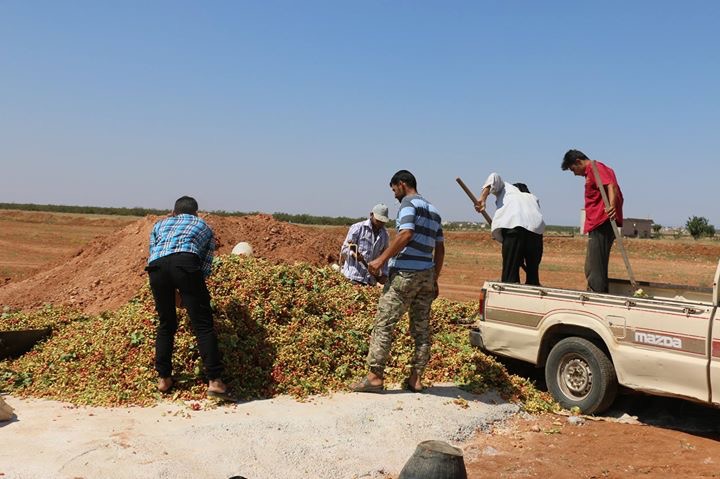
Ashouri is the most widely known pistachio variety in Syria. It occupies the first place of the area of cultivated land, and 85% of Murak’s utilized agricultural land. Its fruits are characterized by a dark red color and a high rate of split open shells. It is followed by Batouri, which accounts for 5% of the land area, and has a distinctive pink color. Then there is Alimi, which also occupies 5% of the cultivated land, with trees characterized by branches hanging like an umbrella, and the external shell of its fruits splitting open themselves at maturity. Other varieties spread over the remaining 5% of the orchards in the region include Bunduki, Nab Al-Jamal, and Abu Reha.Al
Al-Najjar explained to SyriaUntold the different phases of harvest season.
“We pick the pistachio fruits over two stages," he said. "The first is known as ajar (green cores), whose harvest extends from mid-July until early August. The seed in this stage is light green and not fully matured. It is sold to oriental desserts and ice cream makers. The second stage comes after the mid-August, which is the stage of the ripe harvest, where the seed becomes red and the yield is sold primarily to nuts roasters, with some sold fresh on the market.”
Al-Najjar said farmers were forced to reap their crops earlier over the past six seasons due to the deteriorating security conditions, frequent shelling of agricultural land, and acts of theft, looting and cutting down trees for firewood, a widespread practice in the area.
“I spent my entire childhood caring for these trees,” Al-Najjar said in a disheartened tone, gesturing towards his orchard. “They are over 70-years-old. A pistachio tree needs full care for 10 to 15 years to start producing.”
High Costs and Low Yields
The cultivation of pistachios in Murak has stagnated over the past few years under the country’s conditions of war, starting with the city’s takeover by regime forces, and their preventing villagers from accessing their orchards, and ending with its control by opposition factions and its rendering a heated frontline in confrontation with the regime’s forces.
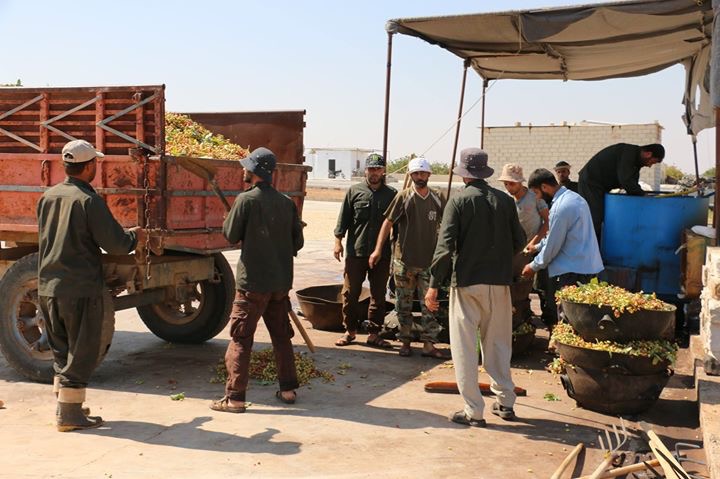
Media activist Alaa Al-Hamwi from the village of Kafr Zita in the northern countryside of Hama said the regime forces that were stationed in the area prevented the people of the city from entering their land to harvest their crops. They also seized machinery used for peeling and cracking pistachios, transferring them to their own areas of control. And a number of soldiers were dedicated to stealing the pistachio harvest, processing the nuts and selling them for the benefit of their commanding officer. Syrian soldiers were also responsible for uprooting and burning hundreds of trees under the pretext of road clearance.
Al-Hamwi pointed out that some locals brokered deals with the officers in charge of checkpoints near their farms, who would take a certain percentage of the profits in return for allowing the villagers to harvest their crops, and granting them protection from arrest at the time. All of this led to a decline in production as the care provided to trees deteriorated.
Farmer Ahmed Al-Saleh (43), a native of Murak, blamed the poor provision of agricultural services coupled with the repeated and long-term displacement of locals outside the city for the decline in production. In the absence of irrigation, fertilizers and pesticides, yield has declined to a sixth of what it was in 2011. One hectare of cultivated land yielded around 50 kilograms of pistachios this year, compared to 300 kilograms in 2011, he noted.
Many farmers found themselves unable to buy fertilizers and pesticides, or to rent the agricultural equipment necessary to plow their lands due to the obscenely high prices," he added. "The price of urea fertilizers reached 175,000 Syrian pounds (approximately $350) per ton this year, compared to 63,000 SYP (about $120) in 2011. The price of phosphorus fertilizers soared from 5,000 SYP to 150,000 SYP (nearly 300 USD). The cost of tillage also jumped from 50 SYP ($1 in 2011) to 1,000 SYP ($2) per dunam [about 900 square metres].”
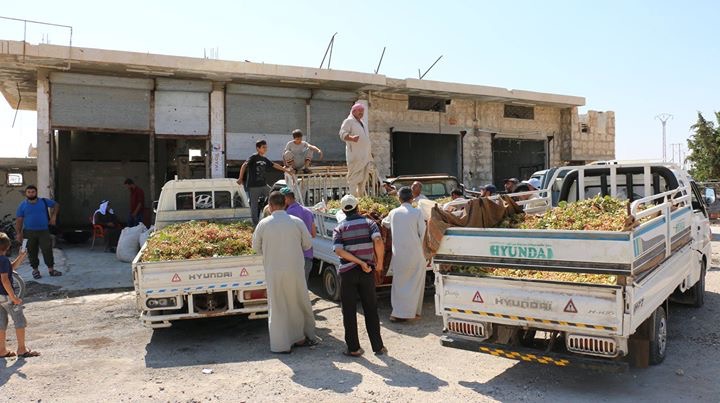
Pistachio sales were not high enough to offset such costs.
“Most traders declined to export our crops, settling for sales within opposition-controlled areas in northern Syria this season," he said to SyriaUntold. "This is due to to the inaccessibility of shipping routes except for those controlled by the regime, which impose high taxes and tarrifs on traders, not to mention theft of cargo, detention risk for drivers and the high transportation costs through the Murak commercial crossing."
Ahrar Al-Sham and Syrian regime forces agreed on October 12, 2017, after the bulk of the crops had been exported to Lebanon, Turkey, Jordan and the Arabian Gulf, which caused great losses for local farmers and traders.
Pests and Diseases
The neglect of pistachio trees, the delay in their watering, and the scarcity of insecticides have led to their infection with diseases, which poses one of the biggest challenges for farmers.
“There are many diseases and insects that have affected the pistachio trees as a result of neglect and lack of care, including capnodis, cyclamen mites, mealybugs, aphids, chaetoptelius vestitus, and twig borer beetles,” said agricultural engineer Khadija Al-Othman. “Most of them are treated by spraying trees with insecticides, applying grass traps and trimming twigs, except for the Psylla insect, one of the most dangerous pests for the crop, which can only be controlled by a releasing an insect known as “green lacewings” which is capable of expelling it.”
Al-Othman added: “The most prevalent pest affecting the crops and trees themselves is the capnodis, which is capable of killing the pistachio tree within a single year, and whose symptoms are yellowing and undergrowth of leaves, delayed vegetative growth and the emergence of a large amount of gum in the larval concentrations.”
The agricultural engineer stressed the need to pursue agreement among the Local Council in Murak and the organizations and associations working in the area to find radical solutions to all the difficulties faced by farmers, the most important of which is the provision of pesticides that farmers cannot secure themselves.

The Pistachio Market Reemerges
Merchants of Murak, with the help of the Local Council, decided to restore the pistachio market and revive its commercial activity this year.
“Civil Defense teams operating in northern Hama villages have cleared rubble and debris from the pistachio market in Murak,” said media activist Wassim Al-Atrash, a native of Khan Shaykhun. “It was founded 13 years ago and it was the most famous in Syria until the war, which destroyed more than 80% of the market. The market once sprawled across an area of some 8,000 square meters along the Damascus-Aleppo international highway. The owners of damaged shops have taken upon themselves the restoration of their shops and are preparing for this years season.”
Al-Atrash pointed out that the Local Council of Murak oversaw the rehabilitation of the market and provided facilitation to merchants, such as arranging annual contracts with formal fees and communicating with the humanitarian organizations based in northern Syria, to compensate farmers for damages and provide them with pesticides, with the aim of reinvigorating economic activity in the town. In the absence of government institutions which previously oversaw public property in the area, the local council has taken ownership of the marekt.
The installation of a Turkish observation post east of Murak restored safety and life to the town, prompting traders to start rehabilitating the market and reopen it, especially after the guarantees given by the officer in charge of the post to the people of the area’s protection from any future military activity, according to Al-Atrash.
Samer Al-Abdallah (52), a merchant of pistachio nuts in northern Syria, was encouraged by the pace of sales even if pistachios were fetching a below average price.
“The market saw a very popular reception from merchants, farmers and locals,"Al-Abdallah said. "Hundreds of cars arrive daily from several areas in northern Syria. The fluctuation of prices played an important role in this turnout, and sales ranged from 2,000 to 2,500 tons a day.”
He noted that a kilogram of pistachios this year had a market cost ranging from 900 to 1,200 Syrian pounds ($2.5), compared to 1,500 to 2,100 Syrian pounds ($3-4) per kilo in 2017.
"This is due to the surplus production and the large quantities on the local market as a result of traders refusing to export them through the regime’s road and opting to sell them to locals and sweet shopkeepers and restaurants in the liberated areas only,” he said.
If progress continues to be made, Al-Abdallah is convinced the market has the potential of putting the town back on the map and creating much needed employment opportunities for Murak residents.
A Source of Livelihood for Manufacturers too
There are many workers in other sectors that benefit from the pistachio season in northern Syria, especially the owners of blacksmith workshops. As the harvest season of pistachios approaches, farmers and traders go to these workshops to manufacture equipment and machinery for picking, peeling and cracking the yield.
Imad Al-Sabbagh (39), a blacksmith who hails from the village of Halfaya and is a resident of the village of Kafrsajna south of Idlib, said the demand for peeling machines increases in July as the pistachio harvest season approaches. The machines he makes are capable of stripping three tons of pistachio per day, or 250 kilograms per batch.

“The cost of the peeling machine ranges between 1,100,000 and 1,200,000 Syrian pounds($2,200)," he said. "The harvest is placed in a peeling compartment, in which the pistachio is peeled and dried. The green outer crust is used as fertilizer for agricultural land after its fermentation for several days, while the internal hard shell is used for heating within special stoves that many people in northern Syria depend upon.”

Pistachio has also become a source of fuel in the course of the war, according to the account of Moataz Kaddou (27), a handicraft workshop owner in the town of Al-Tamanah, just south of Idlib.
“We resorted to designing heaters that burn pistachio shells instead of fuel, due to the high price of fuel in all Syrian provinces, but especially in areas beyond the control of the regime in northern Syria,” he told SyriaUntold. “A heater consumes one ton of pistachio shells per year at a cost not exceeding 90,000 Syrian pounds (about 180 USD) which is less than the cost of a single barrel of diesel fuel.
The price of a heater is approximately 70 Syrian pounds ($140), with the price varying according to whether its compartment is made from steel, zinc or aluminium, he noted.
Most of the locals of Murak depend on the cultivation of pistachio trees, which in normal times provide a decent revenue and source of livelihood, and could do so again. The climate is typically helpful to production with high rates of rainfall providing sufficient water in most seasons. But if the security situation in the region fails to improve, production will stall further and farmers will look for other opportunities to avert further losses.
At present Murak's pistachio farmers are unable to access export markets. They have no choice but to sell their large harvests locally at prices below production cost due to the difficult living conditions in opposition-controlled areas of northern Syria.


